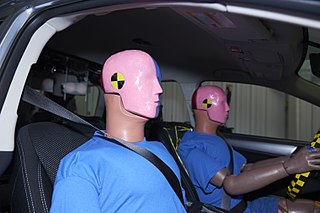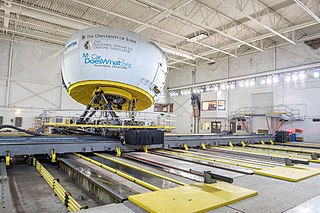Related Research Articles

A simulation is an imitative representation of a process or system that could exist in the real world. In this broad sense, simulation can often be used interchangeably with model. Sometimes a clear distinction between the two terms is made, in which simulations require the use of models; the model represents the key characteristics or behaviors of the selected system or process, whereas the simulation represents the evolution of the model over time. Another way to distinguish between the terms is to define simulation as experimentation with the help of a model. This definition includes time-independent simulations. Often, computers are used to execute the simulation.

A flight simulator is a device that artificially re-creates aircraft flight and the environment in which it flies, for pilot training, design, or other purposes. It includes replicating the equations that govern how aircraft fly, how they react to applications of flight controls, the effects of other aircraft systems, and how the aircraft reacts to external factors such as air density, turbulence, wind shear, cloud, precipitation, etc. Flight simulation is used for a variety of reasons, including flight training, the design and development of the aircraft itself, and research into aircraft characteristics and control handling qualities.

A crash test dummy, or simply dummy, is a full-scale anthropomorphic test device (ATD) that simulates the dimensions, weight proportions and articulation of the human body during a traffic collision. Dummies are used by researchers, automobile and aircraft manufacturers to predict the injuries a person might sustain in a crash. Modern dummies are usually instrumented to record data such as velocity of impact, crushing force, bending, folding, or torque of the body, and deceleration rates during a collision.

The University of Iowa is a public research university in Iowa City, Iowa, United States. Founded in 1847, it is the oldest university in the state. The University of Iowa is organized into 12 colleges offering more than 200 areas of study and seven professional degrees.

A Stewart platform is a type of parallel manipulator that has six prismatic actuators, commonly hydraulic jacks or electric linear actuators, attached in pairs to three positions on the platform's baseplate, crossing over to three mounting points on a top plate. All 12 connections are made via universal joints. Devices placed on the top plate can be moved in the six degrees of freedom in which it is possible for a freely-suspended body to move: three linear movements x, y, z, and the three rotations.

Driving simulators are used for entertainment as well as in training of driver's education courses taught in educational institutions and private businesses. They are also used for research purposes in the area of human factors and medical research, to monitor driver behavior, performance, and attention and in the car industry to design and evaluate new vehicles or new advanced driver assistance systems.
The Virtual Reality Applications Center (VRAC) is a research center within the Engineering Teaching and Research Complex (ETRC) at Iowa State University (ISU) and is involved in advanced research of virtual reality (VR), augmented reality (AR), human computer interaction (HCI), visualization, and is home to the world's highest resolution immersive virtual reality facility, known as the C6.
The Computerworld Smithsonian Award is given out annually to individuals who have used technology to produce beneficial changes for society. Nominees are proposed by a group of 100 CEOs of information technology companies. The award has been given since 1989.

The Driving Safety Research Institute (DSRI) at the University of Iowa College of Engineering houses the National Advanced Driving Simulator (NADS-1) and a fleet of instrumented on-road research vehicles. The NADS-1 is one of the largest ground vehicle driving simulators in the world.

Immersion into virtual reality (VR) is a perception of being physically present in a non-physical world. The perception is created by surrounding the user of the VR system in images, sound or other stimuli that provide an engrossing total environment.

The Institute for Transport Studies (ITS) is a school within the Environment Faculty of the University of Leeds in the UK. The institute is one of the leading centres for teaching and research in transport in the United Kingdom, and attracts a number of students from outside the UK for its Masters and PhD programmes.
James Joseph "Jim" Tomkovicz is an American educator and legal scholar. He is a professor of law at the University of Iowa College of Law. Tomkovicz has authored six amicus curiae briefs in the Supreme Court of the United States; most recently, he was on the winning side of a 5–4 decision in Arizona v. Gant.

OrthoCAD Network Research Cell is a federally funded research and development facility in the Indian Institute of Technology Bombay, Mumbai, India. The Laboratory's primary function is the design and development of reconstruction systems for orthopaedic and other applications, the current focus is on mega-implants for limb-saving surgery, mainly for children affected by bone cancer. The Cell later led to the establishment of Biomedical Engineering and Technology (incubation) Centre (BETiC).
The ADMS is an emergency and disaster management training simulation system designed to train incident commanders, first responders, and incident command teams in a real-time, interactive virtual reality environment. ADMS was first introduced by Environmental Tectonics Corporation (ETCC:US) in 1992. The development of ADMS was in response to the crash of British Airtours Flight 28M at the Manchester airport in 1985, in which 55 people died. Following the accident research indicated that first responder training should include realistic scenarios. The first ADMS system was produced for the UK Ministry of Defence, and delivered to Royal Air Force's (RAF) Manston Facility. Since its inception, ADMS has evolved into a modular, expandable disaster simulation platform, with systems in use worldwide.
Pam-Crash is a software package from ESI Group used for crash simulation and the design of occupant safety systems, primarily in the automotive industry. The software enables automotive engineers to simulate the performance of a proposed vehicle design and evaluate the potential for injury to occupants in multiple crash scenarios.
The Virtual Soldier Research program (VSR) is a research group within the University of Iowa Center for Computer-Aided Design (CCAD). VSR was founded by Professor Karim Abdel-Malek in 2003 through external funding from the US Army Tank Automotive Command (TACOM) to put the Warfighter at the center of US Army product designs. Professor Abdel-Malek's background in robotics and the use of rigorous mathematical formulations was the first introduction of mathematical kinematics to the field of Digital Human Modeling (DHM). Prior to 2003, all DHM models were based on experimental data that use lookup tables to enable the posturing of simple mannequins. Indeed, the first version of Santos, presented at the a DHM conference was met with great success because it was the first fully articulated digital human model that behaved as humans do, whereby joints had constraints and a user could pull on an arm for example and as a result the entire body would respond accordingly. Cost functions representing human performance measures were used to drive the motion within the optimization formulation. Seated posture prediction for example was accomplished by simply providing the seat geometry. The posture prediction methodology was subsequently validated Later on, the Predictive Dynamics method was created and used the same optimization technique with the addition of 3D laws of motion. The Santos system includes many aspects of physiology modeling, thermal, hand model, grasp prediction, gait analysis including stability, mobility, suitability, survivability, maintainability, training, and many other metrics typically used in the assessment of human performance for the Warfighter.
Susan J. Curry is an American health management and policy scholar. She retired from the University of Iowa in 2020 and is currently emerita dean and distinguished professor in the College of Public Health at the University of Iowa. She served as Interim Executive Vice President and Provost at University of Iowa from 2017 to 2019.
Humanetics is a Digital Industrial Technology company, and a leading provider of safety systems, anthropomorphic test devices, crash test equipment, simulation software, CAE models, precision sensors, fiber optics and cutting-edge laser material engineering solutions.

Thurmon E. Lockhart is an American biomedical engineer, researcher and educator. He is the Inaugural MORE Foundation Professor of Life in Motion at Arizona State University, a guest professor at Ghent University in Belgium and, serves as a research affiliate faculty at Mayo Clinic College of Medicine and Science. He is an associate editor of Annals of Biomedical Engineering and academic and guest editor of the Sensors journal He has worked significantly to bring research to practice with various businesses to reduce falls.
Michelle Marie Scherer is the Donald E. Bently Professor of Engineering at the University of Iowa. Her research considers environmental geochemistry, in particular redox-reactions at mineral-water interfaces. In 2009 she was awarded the Association of Environmental Engineering and Science Professors Distinguished Service Award.
References
- ↑ "Home". ccad.uiowa.edu.
- ↑ "Edward J. Haug | College of Engineering". www.engineering.uiowa.edu. Archived from the original on 2012-10-26.
- ↑ Freeman, J., Watson, G., Papelis, Y., Lin, T. et al. "The Iowa Driving Simulator: An Implementation and Application Overview," SAE Technical Paper 950174, 1995, doi: 10.4271/950174.
- ↑ Garrott, R., Mazzae, E.N., and Goodman, M.J., "NHTSA's National Advanced Driving Simulator Research Program," NHTSA paper no. 05-0377. Accessed at http://www-nrd.nhtsa.dot.gov/pdf/esv/esv19/05-0377-O.pdf
- ↑ Abdel-Malek, K., Yang, J., Kim, J.H., Marler, T., Beck, S., Swan, C., Frey-Law, L., Mathai, A., Murphy, C., Rahmatalla, S., and Arora, J. "Development of the Virtual-Human Santos™," V.G. Duffy (Ed.): Digital Human Modeling, HCII 2007, LNCS 4561, pp. 490-499, 2007.